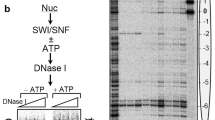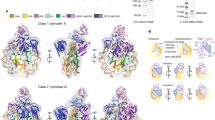Abstract
Chromatin-remodeling complexes regulate access to nucleosomal DNA by mobilizing nucleosomes in an ATP-dependent manner. In this study, we find that chromatin remodeling by SWI/SNF and ISW2 involves DNA translocation inside nucleosomes two helical turns from the dyad axis at superhelical location-2. DNA translocation at this internal position does not require the propagation of a DNA twist from the site of translocation to the entry/exit sites for nucleosome movement. Nucleosomes are moved in 9- to 11- or ∼50-base-pair increments by ISW2 or SWI/SNF, respectively, presumably through the formation of DNA loops on the nucleosome surface. Remodeling by ISW2 but not SWI/SNF requires DNA torsional strain near the site of translocation, which may work in conjunction with conformational changes of ISW2 to promote nucleosome movement on DNA. The difference in step size of nucleosome movement by SWI/SNF and ISW2 demonstrates how SWI/SNF may be more disruptive to nucleosome structure than ISW2.
This is a preview of subscription content, access via your institution
Access options
Subscribe to this journal
Receive 12 print issues and online access
$189.00 per year
only $15.75 per issue
Buy this article
- Purchase on Springer Link
- Instant access to full article PDF
Prices may be subject to local taxes which are calculated during checkout






Similar content being viewed by others
References
Pazin, M.J. & Kadonaga, J.T. SWI2/SNF2 and related proteins: ATP-driven motors that disrupt protein-DNA interactions? Cell 88, 737–740 (1997).
Lusser, A. & Kadonaga, J.T. Chromatin remodeling by ATP-dependent molecular machines. Bioessays 25, 1192–1200 (2003).
Kassabov, S.R., Henry, N.M., Zofall, M., Tsukiyama, T. & Bartholomew, B. High-resolution mapping of changes in histone-DNA contacts of nucleosomes remodeled by ISW2. Mol. Cell. Biol. 22, 7524–7534 (2002).
Zofall, M., Persinger, J. & Bartholomew, B. Functional role of extranucleosomal DNA and the entry site of the nucleosome in chromatin remodeling by ISW2. Mol. Cell. Biol. 24, 10047–10057 (2004).
Kassabov, S.R., Zhang, B., Persinger, J. & Bartholomew, B. SWI/SNF unwraps, slides, and rewraps the nucleosome. Mol. Cell 11, 391–403 (2003).
Lorch, Y., Zhang, M. & Kornberg, R.D. RSC unravels the nucleosome. Mol. Cell 7, 89–95 (2001).
Flaus, A. & Owen-Hughes, T. Mechanisms for nucleosome mobilization. Biopolymers 68, 563–578 (2003).
Logie, C., Tse, C., Hansen, J.C. & Peterson, C.L. The core histone N-terminal domains are required for multiple rounds of catalytic chromatin remodeling by the SWI/SNF and RSC complexes. Biochemistry 38, 2514–2522 (1999).
Imbalzano, A.N., Kwon, H., Green, M.R. & Kingston, R.E. Facilitated binding of TATA-binding protein to nucleosomal DNA. Nature 370, 481–485 (1994).
Luger, K., Mader, A.W., Richmond, R.K., Sargent, D.F. & Richmond, T.J. Crystal structure of the nucleosome core particle at 2.8 A resolution. Nature 389, 251–260 (1997).
Schiessel, H., Widom, J., Bruinsma, R.F. & Gelbart, W.M. Polymer reptation and nucleosome repositioning. Phys. Rev. Lett. 86, 4414–4417 (2001).
Langst, G. & Becker, P.B. Nucleosome mobilization and positioning by ISWI-containing chromatin-remodeling factors. J. Cell Sci. 114, 2561–2568 (2001).
van Holde, K. & Yager, T. Models for chromatin remodeling: a critical comparison. Biochem. Cell Biol. 81, 169–172 (2003).
Saha, A., Wittmeyer, J. & Cairns, B.R. Chromatin remodeling by RSC involves ATP-dependent DNA translocation. Genes Dev. 16, 2120–2134 (2002).
Langst, G. & Becker, P.B. ISWI induces nucleosome sliding on nicked DNA. Mol. Cell 8, 1085–1092 (2001).
Aoyagi, S. & Hayes, J.J. hSWI/SNF-catalyzed nucleosome sliding does not occur solely via a twist-diffusion mechanism. Mol. Cell. Biol. 22, 7484–7490 (2002).
Lorch, Y., Davis, B. & Kornberg, R.D. Chromatin remodeling by DNA bending, not twisting. Proc. Natl. Acad. Sci. USA 102, 1329–1332 (2005).
Havas, K., Whitehouse, I. & Owen-Hughes, T. ATP-dependent chromatin remodeling activities. Cell. Mol. Life Sci. 58, 673–682 (2001).
Schwanbeck, R., Xiao, H. & Wu, C. Spatial contacts and nucleosome step movements induced by the NURF chromatin remodeling complex. J. Biol. Chem. 279, 39933–39941 (2004).
Narlikar, G.J., Phelan, M.L. & Kingston, R.E. Generation and interconversion of multiple distinct nucleosomal states as a mechanism for catalyzing chromatin fluidity. Mol. Cell 8, 1219–1230 (2001).
Kassabov, S.R. & Bartholomew, B. Site-directed histone-DNA contact mapping for analysis of nucleosome dynamics. Methods Enzymol. 375, 193–210 (2004).
Kagalwala, M.N., Glaus, B.J., Dang, W., Zofall, M. & Bartholomew, B. Topography of the ISW2-nucleosome complex: insights into nucleosome spacing and chromatin remodeling. EMBO J. 23, 2092–2104 (2004).
Lowary, P.T. & Widom, J. New DNA sequence rules for high affinity binding to histone octamer and sequence-directed nucleosome positioning. J. Mol. Biol. 276, 19–42 (1998).
Juan, L.J., Utley, R.T., Vignali, M., Bohm, L. & Workman, J.L. H1-mediated repression of transcription factor binding to a stably positioned nucleosome. J. Biol. Chem. 272, 3635–3640 (1997).
Saha, A., Wittmeyer, J. & Cairns, B.R. Chromatin remodeling through directional DNA translocation from an internal nucleosomal site. Nat. Struct. Mol. Biol. 12, 747–755 (2005).
Becker, P.B. & Horz, W. ATP-dependent nucleosome remodeling. Annu. Rev. Biochem. 71, 247–273 (2002).
Anderson, J.D. & Widom, J. Sequence and position-dependence of the equilibrium accessibility of nucleosomal DNA target sites. J. Mol. Biol. 296, 979–987 (2000).
Anderson, J.D., Thastrom, A. & Widom, J. Spontaneous access of proteins to buried nucleosomal DNA target sites occurs via a mechanism that is distinct from nucleosome translocation. Mol. Cell. Biol. 22, 7147–7157 (2002).
Edayathumangalam, R.S., Weyermann, P., Dervan, P.B., Gottesfeld, J.M. & Luger, K. Nucleosomes in solution exist as a mixture of twist-defect states. J. Mol. Biol. 345, 103–114 (2005).
Muthurajan, U.M. et al. Structure and dynamics of nucleosomal DNA. Biopolymers 68, 547–556 (2003).
Flaus, A., Rencurel, C., Ferreira, H., Wiechens, N. & Owen-Hughes, T. Sin mutations alter inherent nucleosome mobility. EMBO J. 23, 343–353 (2004).
Strohner, R. et al. A 'loop recapture' mechanism for ACF-dependent nucleosome remodeling. Nat. Struct. Mol. Biol. 12, 683–690 (2005).
Fan, H.Y., He, X., Kingston, R.E. & Narlikar, G.J. Distinct strategies to make nucleosomal DNA accessible. Mol. Cell 11, 1311–1322 (2003).
Mizuguchi, G. et al. ATP-driven exchange of histone H2AZ variant catalyzed by SWR1 chromatin remodeling complex. Science 303, 343–348 (2004).
Bruno, M. et al. Histone H2A/H2B dimer exchange by ATP-dependent chromatin remodeling activities. Mol. Cell 12, 1599–1606 (2003).
Luger, K., Rechsteiner, T.J. & Richmond, T.J. Preparation of nucleosome core particle from recombinant histones. Methods Enzymol. 304, 3–19 (1999).
Tsukiyama, T., Palmer, J., Landel, C.C., Shiloach, J. & Wu, C. Characterization of the imitation switch subfamily of ATP-dependent chromatin-remodeling factors in Saccharomyces cerevisiae. Genes Dev. 13, 686–697 (1999).
Sengupta, S.M. et al. The interactions of yeast SWI/SNF and RSC with the nucleosome before and after chromatin remodeling. J. Biol. Chem. 276, 12636–12644 (2001).
Sengupta, S.M., Persinger, J., Bartholomew, B. & Peterson, C.L. Use of DNA photoaffinity labeling to study nucleosome remodeling by SWI/SNF. Methods 19, 434–446 (1999).
Acknowledgements
This work was supported by Public Health Service grants GM 48413 and GM 70864. We would like to thank M. Kagalwala (M.D. Anderson Cancer Center) for ISW2 and B. Zhang (Thomas University) for SWI/SNF and members of B.B.'s laboratory for helpful discussions.
Author information
Authors and Affiliations
Corresponding author
Ethics declarations
Competing interests
The authors declare no competing financial interests.
Rights and permissions
About this article
Cite this article
Zofall, M., Persinger, J., Kassabov, S. et al. Chromatin remodeling by ISW2 and SWI/SNF requires DNA translocation inside the nucleosome. Nat Struct Mol Biol 13, 339–346 (2006). https://doi.org/10.1038/nsmb1071
Received:
Accepted:
Published:
Issue Date:
DOI: https://doi.org/10.1038/nsmb1071
This article is cited by
-
Functionalized graphene-oxide grids enable high-resolution cryo-EM structures of the SNF2h-nucleosome complex without crosslinking
Nature Communications (2024)
-
SWI/SNF Chromatin Remodelers: Structural, Functional and Mechanistic Implications
Cell Biochemistry and Biophysics (2023)
-
Phenotypic and molecular spectra of patients with switch/sucrose nonfermenting complex-related intellectual disability disorders in Korea
BMC Medical Genomics (2021)
-
Direct observation of coordinated DNA movements on the nucleosome during chromatin remodelling
Nature Communications (2019)
-
Structural rearrangements of the histone octamer translocate DNA
Nature Communications (2018)



